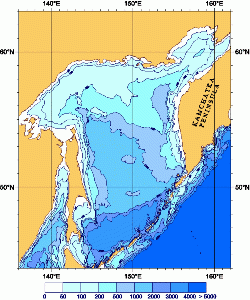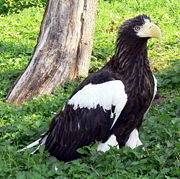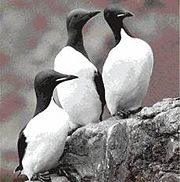Sea of Okhotsk
The Sea of Okhotsk (Russian: ÐÑ Ð¾ÌÑÑкое моÌÑе; English Transliteration: Okhotskoye More, Japanese: OhÅtsuku-kai (ãªãã¼ãã¯æµ·) is a northwestern arm of the Pacific Ocean, situated between the Kamchatka Peninsula to the east, the Kuril Islands to the southeast, the island of HokkaidÅ to the far south, the island of Sakhalin to the west, and a long stretch of eastern Siberian coast (including the Shantar Islands) along the west and north. It is named after Okhotsk, the first Russian settlement in the Far East.
This expansive seaâ611,000 square miles (1,583,000 sq km)âis considered one of the richest north temperate marine ecosystems in the world, and one of the most biologically productive of the worldâs seas. It is home to an abundance of fish, bird and marine mammal life. Known as a "bird lover's paradise," the Okhotsk Sea's shores serve as a haven for large colonies of the common and thick-billed murres, tufted puffins, and Steller's sea eagle, the world's largest raptor. The steller sea lion and the northern fur seal abound in the Okhotsk region.
The Okhotsk Sea, and its fishing industry, is crucial to the economies of far eastern Russia, the Kamchatka Peninsula, the Sakhalin Islands, and Japan. Although there has been some depletion due to overfishing, the Sea has not seen the devastation that some other fishing areas, such as the Grand Banks on Canada's eastern coast, experienced in the late twentieth century.
Geography




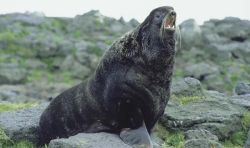
The Sea of Okhotsk is a northwestern arm of the Pacific Ocean. With the exception of HokkaidÅ, one of the Japanese Home Islands, the sea is surrounded on all sides by territory administered by the Russian Federation. It is, therefore, generally considered as being in Russia's domain.
It touches the east coast of Asia from Cape Lazarev to the mouth of the Penzhina River on its west and north. It is bounded on the east and southeast by the Kamchatka Peninsula and the Kuril Islands, while the northern coast of the Japanese island of Hokkaido is on its south. Sakhalin Island is on its southwest. It is connected to the Sea of Japan (also known as "Korean East Sea" in North Korea, and "East Sea" in South Korea) on either side of Sakhalin: On the west through the Sakhalin Gulf and the Gulf of Tartary; on the south, through the La Pérouse Strait.
The Sea of Okhotsk covers 611,000 square miles (1,583,000 square km). It has a mean depth of about 2,818 feet (859 meters) and a maximum depth of 11,063 feet (3,372 meters).
In winter, navigation on the Sea is difficult, if not impossible, due to the formation of large ice floes, caused by the large amount of freshwater from the Amur, which lowers the salinity and raises the freezing point of the sea. The distribution and thickness of ice floes depends on several factors, including the location, time of year, water currents, and sea temperatures.
Physiography
Repeated glaciation over the past two million years formed the Sea of Okhotsk. The northern and western continental shelf areas slope to a depth of about 650 feet (200 meters). The remaining area (approximately 70 percent) to the south and east deepens to roughly 5,000 feet (1,500 meters). The deepest part of the Sea lies within the Kuril Basin, west of the Kuril Islands, and extends to a depth of about 8,200 feet (2,500 meters).
Sediment flows into the sea from the continent, primarily via the Amur River. Coastal abrasion and volcanic activity are additional sources of sediment flow. Fine, silt-covered sands, coarse sands, and pebbles mixed together with mussel shells line the sea bottom near the shores, while a clay-diatom silt forms the bottom of the Kuril Basin.
The continental shores of the Okhotsk are generally high and rocky, cut by large rivers such as the Amur. Its island shores are lower. The southeastern coast of Sakhalin Island contains the Gulfs of Aniva and Terpeniya, while the Gulf of Shelikhov lies between the Siberian mainland on the west and the Kamchatka Peninsula on the east. The Taygonos Peninsula divides the northern part of the Shelikhov into the bays of Gizhiga and Penzhina.
Hydrology
The Sea of Okhotsk waters are fed by Pacific waters flowing in through the Kuril Islands straits, waters from the Sea of Japan flowing through the La Perouse Strait, continental drainage and precipitation.
Water moves through the Okhotsk in a counterclockwise direction. Its southwestern section is comparatively warm, due to warmer water flowing in from the Sea of Japan. Currents on its eastern section are warmer than the western, due to warm air from the Pacific. Around the Kuril Islands, water comes into the Sea from around its northern shores, while the southern islands' waters flow from the sea to the ocean.
During the summer months, the Sea's surface temperature rises to 46â54 °F (8â12 °C), while its waters are warmed to a depth of 100 to 165 feet (30 to 50 meters). Average temperature in the deeper waters average 29 to 30 °F (â1.8 to â1 °C). Surface salinity is around 32.5 parts per thousand and lower, while deep water salinity is approximately up to 34 parts per thousand. The cold-water layer in the northwest ranges from 245 to 525 feet (75 to 160 meters), while in the southeastern it can be a matter of a few feet.
The strongest tidal ranges occur at Penzhina Bay (36 to 43 feet [11 to 13 meters]), which are among the strongest in the world, prompting discussions of the development of tidal power sites there. The weakest tides in the Okhotsk are at southeastern Sakhalin (2.6 feet [0.8 meter]).
Ice cover begins to appear at the end of October, reaches its greatest extent in March, and generally disappears in June. However, the ice flows around the Sakhalin gulfs and the region around Shantar Island sometimes remain into July and August. The coastal areas contain solid ice, rather than floating ice as is found in the open sea.
Climate
The coldest sea in East Asia is the Okhotsk, whose temperatures during winter nearly compare to the Arctic. Its western, northern and northeastern regions experience severe winter weather due to influences from the continent. Between October and April temperatures are bitter and the area is ice-covered and dry with little precipitation occurring. A milder maritime climate occurs to the south and southeast due to oceanic influences. January and February are the coldest months, while July and August are the warmest.
February's average monthly air temperature in the northeastern region is â4 °F (â20 °C), north and west of the sea it is â11 °F (â24 °C), and in the southern and southeastern parts it averages 19 °F (â7 °C).
The average August temperature is 54 °F (12 °C) in the northeast, 57 °F (14 °C) in the north and west, and 64 °F (18 °C) in August in the south and southeast.
Annual precipitation varies from 16 inches (400 mm) in the north, 28 inches (710 mm) in the west, and about 41 inches (1,040 mm) in the south and southeast.
Islands
With the exception of Ion Island, which is located in the open sea, all other islands in the Okhotsk Sea are either coastal islands or they belong to the Kuril island chain. The main islands are:
- Sakhalin Island covers approximately 30,120 square miles (78,010 sq km) and is Russia's largest island. Mountainous and forested, it forms the western border of the Sea of Okhotsk, separating it from the Sea of Japan and the Asian continent.
- Hokkaido is Japan's second largest island and the largest, northernmost, and most sparsely populated of its 47 prefectural-level subdivisions. It is 70 percent forested and a tourist attraction due to its natural hot springs.
- The Kuril Islands are a volcanic island archipelago that stretches approximately 750 miles (1,300 km) northeast from HokkaidÅ, to the Kamchatka Peninsula, separating the Sea of Okhotsk on the west from the Pacific Ocean on the east. The chain consists of 22 main islands (most of which are volcanically active) and 36 smaller islets with a total area of 6,000 square miles (15,600 sq km). Administration of these islands are disputed between Russia and Japan.
- The Yam Islands is a small island group located near the coast in the northern Sea of Okhotsk, near the shores of the Pyagin Peninsula. Home to the Steller sea lion and a variety of birds, they are a part of the protected bioregion of the Magadan area.
- The Shantar Islands are a group of fifteen islands that lie in Uda Bay, in the southwestern zone of the Sea of Okhotsk. They are located close to the shores of the Siberian mainland. They have no permanent population, but they are often visited by commercial fishermen who use them as a base.
- Zavyalov Island, formerly Olsky Island, is a relatively large island located in the eastern side of the Gulf of Tauisk. Zavyalov is mountainous and forested, home to the Siberian dwarf Pine (Pinus pumila) and the dwarf birch Betula middendorffii. Its shores are a breeding ground for the steller sea lion.
- The Spafaryev Islands is a double island lying east of the southernmost peninsula enclosing the Gulf of Tauisk, or wider bay of Magadan, from its western side. They are composed of two islands joined by a narrow landspit. The northern and largest of the two, Ryabokon Island, is roughly triangular in shape. Spafaryev Island proper, roughly shovel-shaped, is located at the southern end.
- Talan Island, a small roundish island 7 miles (11 km) to the north of Spafaryev's northern tip, is home to the world's largest colony of tufted puffins.
- The remote and isolated Ion Island, a breeding ground for the steller sea lion, is the only island that is located in the open sea. Administratively, Ion belongs to the Khabarovsk Krai of the Russian Federation.
- Tyuleny Island, off the coast of Sakhalin, is known as a breeding ground for some 100,000 Northern Fur Seal.
Animal life
The Sea of Okhotsk is considered one of the richest north temperate marine ecosystems in the world, and one of the most biologically productive of the worldâs seas. Its variances in water temperature and depth, along with inflow of river drainage, allow it to support a diverse array of animal life, including bird, fish, and marine mammals.
Life in the Okhotsk includes fish such as capelin, cod, flounder, herring, pollack and salmon. Crayfish, sea mussels, sea urchins, polyps, and shrimp are found alongside the Golden king crab, Steller's sea lion, Northern fur seal, Dall's porpoise, Orcas, and Ribbon seals.
The abundant fish life provides food for a variety of birds. Ion Island is not only a breeding ground for the steller sea lion, but is a haven for cliff-dwelling Common and thick-billed murres. Talan Island is home to the world's largest colony of tufted puffins; nearly one million are found here.
The Steller's sea eagle, the world's largest raptor, lives along the Sea of Okhotsk. Only about 7,500 of this species of eagle remain in the world and can only be found here.
The islands and continental shores surrounding the Sea of Okhotsk are filled with salmon rich rivers, beaches lined with fur seals and sea otters, and land roamed by the Kamchatka brown bear, wolves, bighorn sheep, and the Arctic fox.
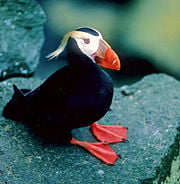 Tufted Puffin, nearly one million are found on Talan Island. |
History
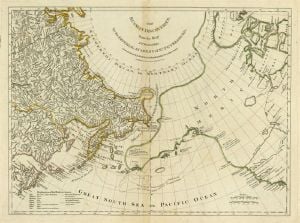
The islands and peninsulas of the Sea of Okhotsk have been inhabited nearly 12,000 years. The indigenous Nivkh people of Sakhalin Island are descendants of the island's original Neolithic settlers. The Orok, Russia's smallest indigenous group, live on the continent's frozen tundra as their ancestors have for centuries. Other groups who live in the area surrounding the sea, or whose ancestors originated in that area, are the Aliutor, Chukchi, Itelmen, Koryak, Even, Evenk (Tungus), Orochi, and Ulchi tribes.
It is said that when Marco Polo returned to Venice in the thirteenth century, he brought maps with him which clearly delineated Sakhalin, Kamchatka, and the Kuril Islands. The Japanese explored Sakhalin Island in 1635, followed by the Russian explorers Ivan Moskvitin and Vassili Poyarkov in the 1640s.
In the 1720s, the Danish explorer Vitus Bering headquartered in the town of Okhotsk, using it as a base from which he launched two expeditions. His second, begun in 1733, and known as the Second Kamchatka Expedition, systematically mapped the entire coast of the sea.
In 1787, the French navigator Jean-François de Galaup, Count de La Pérouse, sailed northward through the strait named for him and crossed the sea to the Kamchatka Peninsula. Ivan Krusenstern explored the eastern coast of the Sakhalin in 1805.
The first and foremost Russian settlement on the shore was the port city of Okhotsk, which relinquished commercial supremacy to Ayan in the 1840s. The Russian-American Company all but monopolized the commercial navigation of the sea in the first half of the nineteenth century.
Mamiya Rinzo and Gennady Nevelskoy determined that the Sakhalin was indeed an island separated from the mainland by a narrow strait. The first detailed summary of the hydrology of the sea was prepared and published by Stepan Makarov in 1894. The expedition of the Soviet research vessel Vityaz, in 1949, marked the beginning of the modern stage of oceanographic research in the sea. Continuing studies have been carried out by Russian scientists.
The Sea of Okhotsk was a hotbed for nineteenth century whaling ships from the United States. Ships would sail from Massachusetts around the tip of South America, to the Sea of Okhotsk, where they would capture whales before returning to the eastern United States. The entire journey took roughly three years, but was undertaken by many in hopes of procuring the revenue associated with the enormous value given to the oil found in whale blubber.
During the Cold War, the Sea of Okhotsk was the scene of several successful U.S. Navy operations (including Operation Ivy Bells) to tap Soviet Navy undersea communications cables. The sea and its surrounding area were also the scene of the Soviet PVO Strany attack on Korean Air Flight 007 in 1983, that killed all aboard. The Soviet Pacific Fleet has used the Sea as a ballistic missile submarine bastion.
Economy
The Sea of Okhotsk supports an incredible range of fish species. Commercially important are crab, shrimp, smelts, capelin, cod, flounder, pollack, herring, and salmon. Fisheries and fish processing are an important economic base for the surrounding areas of Sakhalin, Kamchatka, and Japan. While the regional economy depends on the export of these fishing products, over-exploitation is causing depletion of some of the stocks.
The economic development of eastern Russia depends to a great extent on the sea. Important seaports on the continent are Magadan in Nagayeva Bay and Okhotsk city. Korsakov on Sakhalin Island and Severo-Kurilsk and Yuzhno-Kurilsk on the Kuril Islands are also important. Navigation is complicated through ice floes in the winter and dense fog in the summer.
Twenty-nine zones of possible oil and natural gas deposits have been identified on the seaâs northern shelf. Total reserves are estimated at 3.5 billion tons of equivalent fuel, including 1.2 billion tons of oil and 1.5 billion cubic meters of gas in this area. Discoveries have also been made near Sakhalin Island and along Kamchatka's west coast. The Kamchatka Peninsula is rich in mineral depositsâcoal, copper, gold, and silverâbut development is hindered due to the area's remoteness.
The Kamchatka Peninsula has a growing tourist industry due to its unspoiled nature, including 127 volcanoes, 22 of which are still active, geysers and hot springs, and numerous populations of shorebirds and waterfowl.

Notable seaports
Notable Sea of Okhotsk seaports include:
- Abashiri, HokkaidÅ, Japan
- Magadan, Magadan, Russia
- Monbetsu, HokkaidÅ, Japan
- Palana, Kamchatka, Russia
- Wakkanai, HokkaidÅ, Japan
- Yuzhno-Sakhalinsk, Sakhalin, Russia
While Japan has several notable Okhotsk Sea ports on its island of HokkaidÅ, there is no traditional name in the Japanese language. The Sea is called OhÅtsuku-kai (ãªãã¼ãã¯æµ·), which is a transcription of the Russian name. Additionally, Abashiri Subprefecture, the part of HokkaidÅ which faces the sea, is often called the Okhotsk region (ãªãã¼ãã¯å°æ¹ OhÅtsuku-chihÅ), named after the sea.
ReferencesISBN links support NWE through referral fees
- Kolga, Margus, Igor Tõnurist, Lembit Vaba, and Juri Viikberg. 1993. The Red Book of the People of the Russian Empire. Retrieved May 18, 2020.
- Shmidt, P. Yu. 1965. Fishes of the Sea of Okhotsk. Israel Program for Scientific Translations. ASIN B001I6NBHE
- Shpilenok, Igor, and Patricio Robles Gil. 2008. Kamchatka: Wilderness at the Edge. Sierra Madre. ISBN 978-9689128090
- Sontag, Sherry, Christopher Drew, and Annette Lawrence Drew. 1998. Blind Man's Bluff: The Untold Story of American Submarine Espionage. New York: Public Affairs. ISBN 9781891620089
External links
All links retrieved January 25, 2023.
- Sea of Okhotsk World Atlas
- Earth from Space: Sea of Okhotsk European Space Agency
- Hydrochemical Atlas of the Sea of Okhotsk 2001 NOAA
- Steller's Sea Eagle National Geographic
Credits
New World Encyclopedia writers and editors rewrote and completed the Wikipedia article in accordance with New World Encyclopedia standards. This article abides by terms of the Creative Commons CC-by-sa 3.0 License (CC-by-sa), which may be used and disseminated with proper attribution. Credit is due under the terms of this license that can reference both the New World Encyclopedia contributors and the selfless volunteer contributors of the Wikimedia Foundation. To cite this article click here for a list of acceptable citing formats.The history of earlier contributions by wikipedians is accessible to researchers here:
The history of this article since it was imported to New World Encyclopedia:
Note: Some restrictions may apply to use of individual images which are separately licensed.
